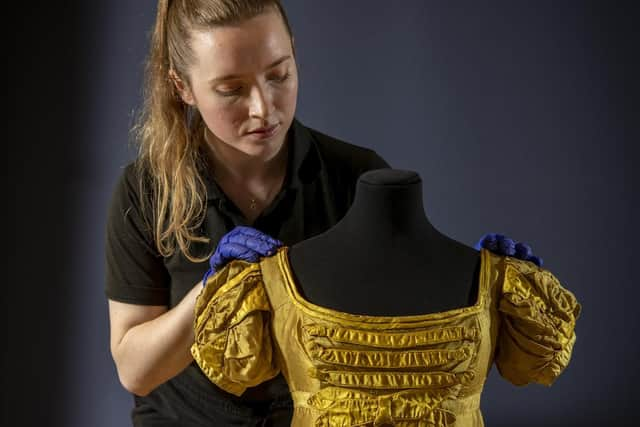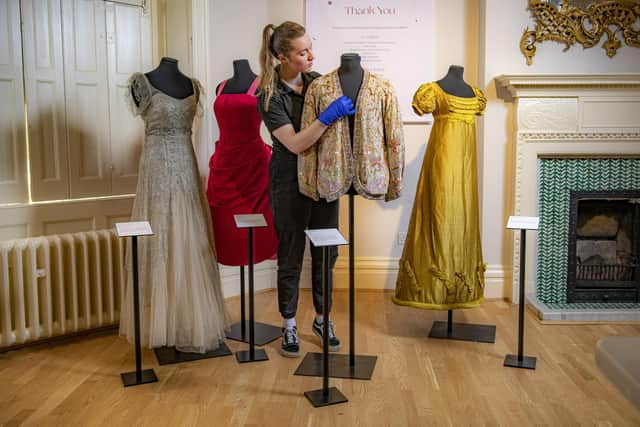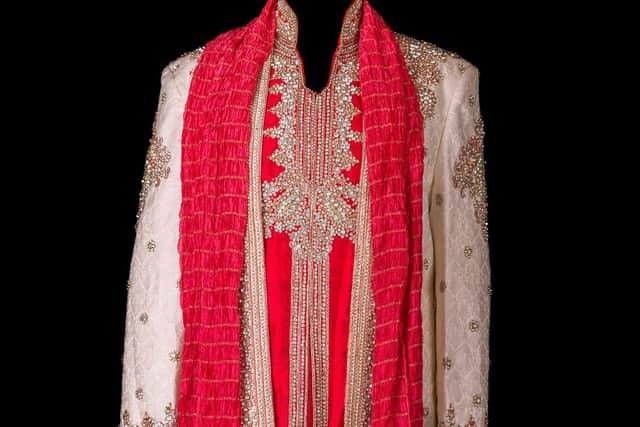From Bridgerton style dresses to hip hop trainers, a new Lotherton Hall fashion exhibition celebrates eveningwear through the ages
For centuries, women, and many men, have been pondering the question, what on earth shall I wear for that? There can be few people who have not contemplated an upcoming big night out – a charity ball, a special birthday party or even just painting the town red – without mentally or physically flinging open our wardrobe doors… and sighing in despair.
Like the special occasions they serve, our dressing-up clothes are important to us, the clothes pegs on our timeline, delineating and elevating our everyday life. We choose these clothes with care, we look back at them and smile. Sometimes we cringe (that bright pink Villanelle tiered tent dress – what was I thinking?)
Advertisement
Hide AdAdvertisement
Hide AdLockdowns put paid to going out, but their lifting has prompted a new exhibition at Lotherton Hall. What Shall I Wear: Eveningwear Through the Ages has opened in the fashion galleries, celebrating two centuries of evening and party wear.


It showcases the traditional, the opulent, the daring and the downright eccentric looks that have been worn after dusk, with pieces from Norman Hartnell, Jean Varon, Zandra Rhodes and Balenciaga, plus a section on re-wearing and a film with views on eveningwear from people in Leeds.
“With lockdown, there was a lot of talk about everybody going more casual, so we decided to celebrate coming out of it,” says Natalie Raw, curator of dress and textiles at Leeds Museums and Galleries.
“We have a whole selection of little black dresses, and a cocktail dress worn by Jacqueline Brotherton-Ratcliffe, wife of George Brotherton-Ratcliffe, chairman of Brothertons Chemicals. She was born in Leeds but they lived in London.
Advertisement
Hide AdAdvertisement
Hide Ad“The 1960s cocktail dress was bought from Fenwicks in London, and has the Susan Small label. The little black dress would have been your staple garment.”


Coco Chanel put the LBD on the fashion map when one of her designs appeared on the front cover of Vogue in 1927, marking a transition into more casual and simple eveningwear.
“It has stayed there in history since then, but it changes with fashion,” says Natalie. “In the 1960s it was the Audrey Hepburn long black dress in Breakfast at Tiffanys, again that simple but elegant look you can dress up for different occasions or wear more casually to a less formal event.”
The oldest piece in the exhibition, from 1817, looks as if it came straight out of Bridgerton, a yellow-gold silk gauze gown with silk satin detailing on the bodice and piping, all hand sewn. “Although it looks quite simple, the construction would have been really complicated and it would have taken a long time to make,” says Natalie.
Advertisement
Hide AdAdvertisement
Hide Ad“It’s that idea that, for women, eveningwear is where you are allowed, or it is expected, that you show more skin, and that is still something today. In the Regency period and throughout the Victorian period, it was more strict. During the day, you would not be showing your neckline and you would have longer sleeves, but for eveningwear, that is when you would have your opportunity to show more.”


The dress has been copied and downsized so that children can try it on at the exhibition, along with a dinner suit.
An exquisitely beaded jacket from the 1920s or ’30s represents a time when Western culture looked east, towards Japan and China, for inspiration. “In the 1920s, they were also really interested in Egypt because of the Tutenkamen discovery,” adds Natalie. “In this country, kimonos were worn as relaxed wear and that feeds into the designs. Today, everybody talks about cultural appropriation and it is that idea of taking something because it looks nice but not fully understanding the culture it has come from.”
There is a pink cocktail dress from the early 1960s designed by Victor Stiebel, who designed Princess Margaret’s going away outfit. “By the 1920s and 30s, cocktail parties had become really popular, and hosting an early-evening, less formal event, even in your own home, and being the perfect housewife, is where the cocktail dress comes into its own,” says Natalie.
Advertisement
Hide AdAdvertisement
Hide AdThere is also a dress from the 1930s by the Queen’s wedding dress designer Norman Hartnell. Natalie says: “The ’30s was still that era of debutantes, the London season and going out to lots of balls and events, the continuation of that idea of trying to find a husband.”


There is a Ukrainian costume loaned by Olga Callaghan, of Leeds, who said: “My mother embroidered the blouse herself. I’ve loaned it so people can see how beautiful the Ukrainian costume is. It will make me extremely proud to see it on show, particularly with everything that is happening in Ukraine at the moment.”
The exhibition also celebrates British hip hop influences on going-out wear, with a denim jacket and trainers from the 1980s and '90s (now vintage style), and there is a sherwani from 2012.
“It was worn by the lender when he got married and it is worn for weddings now,” says Natalie. “Originally, the sherwani was a loose-fitting garment worn by the Mughal nobility. Once the British were in India, there was this mix of cultures, and seeing the British officials in their frock coats, the sherwani developed a more fitted shape, but they kept the colours.”
* What Shall I Wear: Eveningwear Through the Ages continues at Lotherton Hall until October 16. museumsandgalleries.leeds.gov.uk/events/lotherton